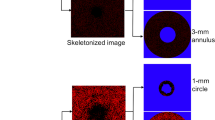Zusammenfassung
Ziel
Evaluierung der Makulafunktion bei Patienten mit Diabetes mellitus Typ II.
Studiendesign
Nichtrandomisierte kontrollierte Fallserie.
Methoden
Bei 25 Patienten mit 50 Augen und nachgewiesenem Diabetes mellitus Typ II wurden das Fixationsund das Sensitivitätsmuster der Makula und die Testantwort (Latenz) mit Hilfe des Mikroperimeters MP-1 (Fa. Nidek) evaluiert und mit klinischen Befunden, aktuellen Blutzuckerwerten und fluoreszenzangiographischen Daten korreliert. Fundusveränderungen wurden anhand der ETDRS-Kriterien klassifiziert. Die Statistik erfolgte mit chi2-Tests.
Ergebnisse
20 Augen (40%, Grp. 1) hatten keinen Hinweis auf eine diabetische Retinopathie, 13 Augen (26%, Grp. 2) hatten eine nichtproliferative Retinopathie ohne und 17 Augen (34%, Grp. 3) eine nichtproliferative Retinopathie mit klinisch signifikantem Makulaödem. 9 Augen (36%) hatten ein seitenungleiches klinisches Bild. Abnormales unstabiles Fixationsmuster: Grp. 1: 8 (40%), Grp. 2: 7 (54%), Grp. 3: 17 (100%), reduzierte retinale Sensitivität Grp. 1: 4 (24%), Grp. 2: 8 (62%), Grp. 3:17 (85%) und verzögerte Testantwort Grp. 1: 8 (40%), Grp. 2: 4 (30%), Grp. 3: 17 (100%). Eine statistisch signifikante Anzahl von Augen (p < 0,0001) in der Studiengruppe zeigte damit unstabile Fixation, verzögerte Testantwort und subnormal retinale Sensitivät und korrelierten mit den klinischen Befunden je nach Erkrankungsstadium.
Schlussfolgerungen
Abnormales Fixationsmuster, reduzierte retinale Sensitivität und verzögerte Testantwort weisen auf einen stadienabhängigen Defekt der intraretinalen Ganglienzellen bei unkontrollierten hohen Blutzuckerwerten hin. Eine frühe Diagnose makulärer Komplikationen bei unkontrolliertem Diabetes kann durch die Mikroperimetrie ermöglicht werden.
Summary
Aim
To evaluate the macular function in patients with diabetes mellitus type II.
Study design
Nonrandomized controlled case series.
Methods
25 patients (50 eyes) with diabetes mellitus Type II and 25 age-matched controls without were randomly subjected to evaluation of the fixation, retinal sensitivity and test response patterns of the macula using the Nidek Microperimeter. The findings were correlated with blood sugar levels and fluorescein angiography. Fundus changes were classified based on ETDRS criteria. Chi square test was applied for statistical analysis.
Results
20 eyes had no evidence of diabetic retinopathy, 13 eyes (26%) had background changes, and 17 eyes (34%) macular edema. 9 patients (36%) had an asymmetrical clinical picture. Abnormal fixation patterns: Grp. 1: 8 (40%), Grp. 2: 7 (54%), Grp. 3: 17(100%), reduced retinal sensitivity Grp. 1: 4 (24%), Grp. 2: 8 (62%), Grp. 3: 17 (85%), and delayed test response: Grp. 1: 8 (40%), Grp. 2: 4 (30%), Grp. 3: 17 (100%). A statistically significant number of eyes (p < 0.0001) in the study group showed unstable fixation, delayed test responses and subnormal retinal sensitivity correlating with the disease process.
Conclusion
Abnormal fixation pattern, reduced retinal sensitivity and prolonged test response indicate defective macular function and is related to the disease process in diabetics. Very early detection of diabetic macular complications in uncontrolled diabetics seems to be possible by microperimetry.
Similar content being viewed by others
Literatur
Klein R (1997) Barriers to prevention of vision loss caused by diabetic retinopathy. Arch Ophthalmol 115: 1073–1075
Bursell SE, Clermont AC, Kinsley BT (1996) Retinal blood flow changes in patients with insulin-dependent diabetes mellitus and no diabetic retinopathy. Invest Ophthalmol Vis Sci 37: 886–897
Leith E, Gardner TW, Barber AJ, Antonetti DA (2000) Retinal neurodegeneration: early pathology in diabetes. Clin Exp Ophthalmol 28: 3–8
Barber AJ (2003) A new view of diabetic retinopathy: a neurodegenerative disease of the eye. Prog Neuropsychopharmacol Biol Psychiatry 27: 283–290
Nidek MP-1 Microperimetry Operator manual NIDEK Technologies USA
Author information
Authors and Affiliations
Corresponding author
Rights and permissions
About this article
Cite this article
Shenoy, R., Bialasiewicz, A., McIlvenny, S. et al. Herabsetzung der retinalen Sensitivität bei Patienten mit unkontrolliertem Diabetes mellitus Typ 2 — eine Studie zur Mikroperimetrie der Makula. Spektrum Augeheilkd 19, 225–227 (2005). https://doi.org/10.1007/BF03163402
Published:
Issue Date:
DOI: https://doi.org/10.1007/BF03163402




